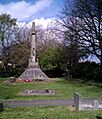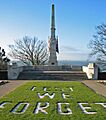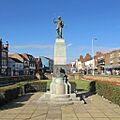Grade II* listed war memorials in England facts for kids
England is home to many special buildings and structures that are protected because they are important to history or architecture. These are called listed buildings. Among them are over 4,000 war memorials, which are places built to remember soldiers and other people who died in wars. About 137 of these war memorials are listed at a very high level called Grade II*. This means they are considered "particularly important buildings of more than special interest."
Contents
What are Listed Buildings?
In England, a listed building is a structure that has special historical or architectural importance. When a building is "listed," it gets legal protection. This means it cannot be torn down or changed without permission from the local government. This helps to keep important parts of England's history safe for future generations.
There are three main categories for listed buildings:
- Grade I: These are the most important buildings. Only about 2.5% of all listed buildings are in this category.
- Grade II*: This is the second highest grade. About 5.5% of listed buildings fall into this group. These buildings are very important and have special historical or artistic value.
- Grade II: This is the most common grade, making up about 92% of all listed buildings. These buildings are still important but are not as rare or unique as those in the higher grades.
Why are Grade II* War Memorials Special?
A war memorial gets a Grade II* listing for several reasons. It might be a stunning piece of art or have a very unusual design. It could also be historically significant, meaning it tells an important story from the past. Even if the person who designed or sculpted the memorial isn't famous, it can still be listed if it's truly special.
`Historic England`, which is the government group in charge of listing buildings, has been working to add more war memorials to the `National Heritage List for England`. This project is part of remembering the 100th anniversary of the `First World War`. This list only includes memorials that are free-standing structures. It does not include plaques on walls or sculptures inside other buildings unless they have their own separate listing.
A Look at England's War Memorials
War memorials in England come in many different shapes and sizes. They remember conflicts that happened over hundreds of years. However, memorials built specifically to honor soldiers and conflicts (rather than just victorious leaders) became common after the `Battle of Waterloo` in 1815. This battle marked the end of the `Napoleonic Wars`.
The `First World War` (1914–1918) led to the creation of far more memorials than any other single conflict. Many of these memorials were later updated to also remember those who died in the `Second World War` (1939–1945). This list also includes five memorials from the `Second Boer War` (1899–1902), four specifically for the Second World War, and one each for the `Seven Years' War` (1756–1763) and the `Crimean War` (1853–1856).
Here are some examples of these important war memorials:
Famous Memorials and Their Stories
- `Mells War Memorial` in `Mells`, Somerset: This memorial remembers those from both the First and Second World Wars. It was designed by the famous architect `Sir Edwin Lutyens` and was officially opened in 1921.
- `Merchant Seamen's Memorial` in `Tower Hill`, London: This memorial garden honors merchant seamen who died in the Second World War. It was designed by `Sir Edward Maufe` and completed in 1955.
- Radcliffe Cenotaph in `Radcliffe, Greater Manchester`: A `Cenotaph` is a monument that honors people buried elsewhere. This one remembers those from the First and Second World Wars and was designed by Sydney Marsh. It was unveiled in 1922.
- `Hoylake and West Kirby War Memorial` in `West Kirby`, Merseyside: This memorial features an `Obelisk` (a tall, four-sided pillar) and sculptures. It was designed by `Charles Sargeant Jagger` and dedicated in 1922.
- `Bromley War Memorial` in `Bromley`, London: Another obelisk with sculptures, this memorial also remembers both World Wars. It was created by `Sydney March` and opened in 1922.
- `79th Regiment Memorial in `Clifton, Bristol`: This is a very old `Cenotaph` from 1766, remembering the `Seven Years' War`. Its architect is unknown, but it shows how long England has honored its soldiers.
- `North Eastern Railway War Memorial` in `York`, North Yorkshire: Designed by `Sir Edwin Lutyens`, this memorial includes an obelisk, screen walls, and a `Stone of Remembrance`. It was built in 1924 for the First and Second World Wars.
- `Cambridge American Cemetery and Memorial` in `Madingley`, Cambridgeshire: This memorial, including a chapel and memorial wall, was designed by Perry Dean Rogers Architects. It honors those who died in the Second World War and was completed in 1954.
- `Commonwealth Air Forces Memorial` in `Runnymede`, Surrey: This large memorial building, designed by `Sir Edward Maufe`, remembers air forces personnel from the Second World War. It was dedicated in 1953.
- `Midland Railway War Memorial` in `Derby`, Derbyshire: Another design by `Sir Edwin Lutyens`, this cenotaph and screen wall honors those from the First World War. It was unveiled in 1921.
- `Manchester Cenotaph` in `St Peter's Square`, Manchester: This famous `Cenotaph` was also designed by `Sir Edwin Lutyens` and remembers both World Wars. It was completed in 1924.
- `Machine Gun Corps Memorial` at `Hyde Park Corner`, London: This sculpture by `Francis Derwent Wood` was unveiled in 1925 to honor the Machine Gun Corps from the First World War.
- `Royal Air Force Memorial` on `Victoria Embankment`, London: Designed by `Sir Reginald Blomfield`, this memorial features a bronze eagle on a plinth. It honors those from the Royal Air Force in both World Wars and was dedicated in 1923.
Images for kids




























































































































